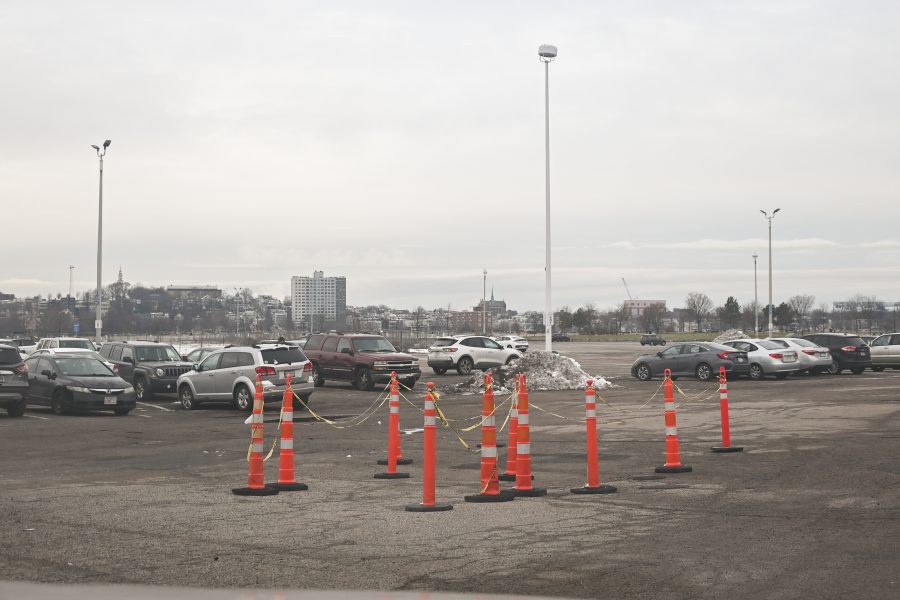On Tuesday, Jan. 17, Chancellor Marcelo Suárez-Orozco—along with Provost Berger—sent out an email to faculty and students regarding the upcoming “Dorchester Bay City” project. The project is essentially a massive new complex of buildings to be developed over at Bayside Lot once our new parking spaces are opened—well, hopefully after that. The email was…weird to say the least.
Glowing language abounded in the email: “Pleased to inform you about the many benefits this development will have” and “critical to UMass Boston, the city, and particularly our Columbia Point neighborhood” and such. The email was framed as a notice that the Boston Planning and Development Agency is holding public hearings on the project, yet while dates and times were given, no links or instructions to actually access these virtual meetings were provided. How convenient.
I’ve been aware of this project—and the issues associated with it, which I will get to in just a minute—since I first came here in the Fall of 2021. I have never encountered a situation in which the top administration officials decided to shill for a private developer’s building project that they are getting money from. $235 million is apparently the right price for leaders of a publicly funded state university to happily and aggressively promote a private development at its doorstep.
It’s gross on its face, but the muck goes even deeper than that. This “Dorchester Bay City” project is a monster. The original plan, according to faculty members from the UMass Boston [RH1] Coalition Against Gentrification and various other departments, was basically a thoughtless, elite-serving monstrosity almost too big to fit on the property. Massive pushback was given from many people. Apparently, the Urban Planning department and the School for the Environment went as far as to recommend a third party to oversee the planning and were asked to deliver a list of possible organizations to do so. I’ll let you guess how seriously the administration took that list.
Its newest iteration is marginally better—and marginally is definitely the right word here. It’s a bit smaller for one thing, and the number of affordable housing units has gone up to 20 percent[1]. Problem is, “affordable” to them means 70 percent of Area Median Income[1] which figures out to be $1,257 in rent per month for a studio, according to Boston Planning and Development Agency. Ironically, this agency is in charge of the public side of the planning process. Keep in mind, this is public property, owned by the UMass Building Authority in trust for UMass Boston.
It’s actually insane that these people think 70 percent AMI is affordable for most Dorchester residents. There is a 10 million dollar “commitment to MAHA homeownership programs” as well, but this is incredibly vague and smells just as rank as “carbon offsets;” basically, damaging one area is supposedly fine and dandy as long as you help improve another area, far away.
There are also vague mentions of throwing money at “workforce training and economic opportunity programs” and “transportation infrastructure improvements.” However, some of my sources believe that the overall lack of specificity on their commitments to job generation, small businesses and valuable community facilities is a major problem. As one professor pointed out to me, this project—despite being public property—doesn’t even meet the rhetorical standards of the Wu Administration.
Honestly, this entire project is reminiscent of what happened in the Seaport or Assembly square. In both cases, a patch of underdeveloped land is bought up by private developers so they can create an isolated enclave for the wealthy elite. Except this time, it’s the property of a public university whose mission is supposedly to be “anti-racist” and “health-promoting” and is heavily promoting its public policy initiatives. The real kicker is that this university is simply refusing to get deeply involved in anti-racist public policy regarding the development on its property.
What’s more, there are serious environmental concerns. Bayside is right on the coast and already floods during storms and high tides. I’ve been told that Dorchester Bay City’s ‘solution’ will be to build on top of a raised platform, but there is no way to catch the water that runs off of it. This means more rapid flooding of surrounding areas, such as the low-income housing nearby and the largely student housing just next to the property.
Again, this university is showing that it is all bark and no bite here. We are supposedly dedicated to environmental justice, resilience and climate change mitigation, yet there is nothing but silence about the environmental impacts of this project.
Another major issue is transportation—because of course. JFK Station is crumbling. Train schedules are still highly inconsistent. Bus routes to Columbia Point are a jumbled mess and underserved. The peninsula is not designed for large traffic patterns, and the roads that do exist are confusing and awful. The traffic pressure of an Assembly Square-style development complex is going to completely overwhelm the area. That vague mention of “transportation infrastructure improvements” doesn’t inspire much confidence.
Some believe that the administration is such a cheerleader for this private development due to chronic underfunding of the university by the state. They are getting paid by the developers, so this probably has truth to it. Let’s get one thing straight—a single payment of $235 million isn’t funding; it’s a drop in the bucket of a giant mountain of debt. Are we really this cheaply bought off?
Look. UMass Boston is a commuter school on a fairly isolated peninsula. In talking with students, there is very little reason for people to spend time in the area outside of class, especially for those who make a long trip. We are pretty divorced from the Dorchester community. I have mused with my colleagues about whether it’s the responsibility of the school or the state to develop the area further. Everyone—including the faculty members of UMass Boston Coalition Against Gentrification understands the need for development in this area, both for Dorchester’s sake and the school’s sake.
But let’s be real, this development, in its current state, is going to price so many people out of the area, and all of Boston will hear about it. Both the school and the state are failing to do what’s right here. The primary tragedy will be the lives it upends, but we also have to think about the long-term consequences for UMass Boston as well.
So, what will happen if this project goes through as-is? The already minimal interface between UMass Boston and Dorchester will be pushed back beyond reach. Low-income people across Boston will see our university as betraying them and betraying our mission statement. Enrollment will drop, and the opportunity we have to improve the lives of people who live in such areas will be severely diminished. This would be an absolute disaster and tragedy.
Here’s the bottom line. Our administration needs to get its priorities in order. Either they need to start taking opportunities to put their proverbial money where their giant freaking mouth is and begin doing actual work to promote anti-racism, community development and justice in public policy…or cave into the fact that, at heart, they are antiquated, unambitious and status-quo suits who love to talk up a big game but are too scared to make a real difference.
So, what is the actual solution? UMass Boston Coalition Against Gentrification is asking for 30 percent of units to be at 25 percent AMI or below; 25 percent of units at 50 percent AMI or below; and a third of units below 75 percent AMI. This would actually be affordable for Dorchester. They are also asking that the project go back to the drawing board so a number of other issues can be solved, such as those involving community spaces, environmental concerns and small business support. Transportation should also be improved before anything opens—our current public transportation situation simply cannot handle any more rider increase.
If you want to get involved, please reach out to the UMass Boston Coalition Against Gentrification. A lot of professors from the Urban Planning department and School for the Environment are members. The staff and faculty unions are involved as well, and members of these cross all departmental and college boundaries. So, ask your professors about it, and see how you can help! It’s really important students show that we aren’t going to support this reckless and thoughtless development, and that we aren’t going to let our administration continue to show a supreme lack of progressive leadership and positive ambition.
You can also attend the remaining public meetings on the development. The one on housing is on Feb, 1 at 6p.m., while the one on transportation is on Feb. 13 at 6p.m. The registration link is on the BPDA website—a quick Google search turns it up. Unfortunately, it seems the link is currently broken…I don’t want to read too much into this, but hopefully, it comes back online so that people can actually attend. Alternatively, you can submit comments currently at the BPDA website as well.
So, get involved, make your voice heard and show Dorchester that UMass Boston students really care!
[1]https://www.baysideupdate.com/
[2]https://www.bostonplans.org/housing/income-asset-and-price-limits
Dorchester Bay City is a harmful mistake
Image of Bayside parking as they start fixing the parking lot. Photo by Olivia Reid / Photography Editor
Contributors
James Cerone, Opinions Editor

Olivia Reid, Photo Editor
Olivia Reid (she/her) is a senior majoring in communications. One of her favorite experiences was covering Taylor Swift’s The Eras Tour and getting to professionally photograph the show.

